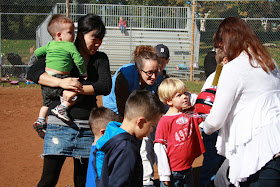We spent a week learning about the Earth and its layers this Fall. One project we did involved building the earth with different colors of play dough (I used a Kool-Aid play dough recipe because I love the vibrant colors). The girls began creating the earth by making a small inner core.
Next they used orange for the outer core and red for the mantle. Next they rolled out a large but thin layer of blue for the crust.
They finished by using green to create continents
The finished product(s)
After they were done I used a knife to cut open the earth so they could see all the layers. The girls thought this was pretty cool, but I really wish I had had a camera rolling when I did this project with my pre-school class. I modified it a bit by having each of my little guys add a layer of the earth. I cannot tell you how amazed they were when we cut open our combined earth. They thought it was beyond cool and amazing! Here's Missy K checking out her layers.
Grammy gave Jackson a Leap Pad Ultra to help him learn letters and numbers while I'm working with the girls on schoolwork. I was surprised he wasn't interested in the play dough activity, but was glad he was willing to sit at the table and listen while still being involved in an educational activity. Meanwhile Daddy came home while we were working on this and he and Miss McKinley (7 1/2 mos here) enjoyed some snuggle time! :)
Having fun with Daddy while the big girls work :)
Another way we explored the layers of the earth was using hard boiled eggs.
We cut the eggs in half and it was easy to see the core, mantle and crust just like the earth. We also discussed that many things (apples, oranges etc) share this same pattern of a core, large middle center and thin outer crust. We found this basic similarity very interesting!
Jackson enjoying eating his "earth"
During our study of the layers of the earth we also discussed volcanos. One fun activity we did to explore how volcanos erupt used Oreos.
We began by splitting the top cookie of the Oreo, then we slid them together so the middle was squished up like lava as the plates shift/move.
Jackson enjoyed participating in this activity :)
Here is another activity we did to review the layers of the earth. I cut out 4 different size circles and had the girls place them on a sheet of paper (kind of like a puzzle). I had written the layers of the earth on our white board so they could copy them in the correct order. This is Kennedy's finished product.
Exploring the Solar System has provided so many fun activities and ways to explore. I have to say as a homeschool mom I really enjoy these science activities as much or more than anything else we do! Thank you Pinterest and Library for all the fabulous ideas and books! :)



















































